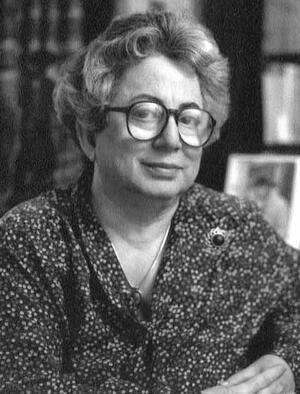“Women in Nuclear History” series #10 Dr. Fay Ajzenberg-Selove – author of “nuclear bible” for nuclear spectroscopy
Dr. Fay Ajzenberg-Selove is mostly recognized for compiling nuclear data of energy levels in light atomic nuclei that were a big part of “nuclear bible”. Her life story is very compelling and her work is monumental. She is our #10 installment in “Women in Nuclear History” series.

- F. Ajzenberg-Selove was born on 13 February 1926 in Berlin to Polish-Jewish family. Her father, Moisei Abramovich Aisenberg, was born in Poland but moved to St. Petersburg as a mining engineer and her mother, Olga Ajzenberg was a talented pianist. They fled Russia to Germany during Soviet revolution.
- The family moved to France during Great Depression; they travelled through Spain, Portugal and Cuba to New York City in 1941 to escape war and Holocaust.
- Fay graduated in 1946 from the University of Michigan with a BS in engineering. Her father encouraged her interests in science. She was THE ONLY WOMAN in a class of 100.
- Fay received her MS in 1949 and her PhD in physics from the University of Wisconsin–Madison in 1952 with a dissertation titled “Energy levels of some light nuclei and their classification” after doing a lot of experimental work with light nuclei.
- She started publishing “Energy Levels of Light Nuclei” together with Thomas Lauritzen at the California Institute of Technology (Caltech) during her postdoctoral work. This was a compilation of the field’s best yearly research regarding nuclear structure and decay of nuclei with an atomic mass number (A) from 5 to 20. During 1973 – 1990 Ajzenberg published in the Journal Nuclear Physics annually revised version.
- F. Ajzenberg-Selove suffered gender-based discrimination through her life. Here is one example: she was initially hired as an assistant professor of physics at Boston University, but the dean lowered her salary 15 percent when he learned Ajzenberg was a woman. Ajzenberg refused the position until the initial salary was restored.
- While at Boston University, she met Harvard University physicist Walter Selove thanks to Marietta Bohr, wife of Niels Bohr’s son Aage. Marietta told Fay that she had met the suitable partner for her, Walter (Wally) Selove, who was a superb experimental physicist at Harvard University; they married in December 1955. Walter eventually discovered a particle that he named for Fay, the f-zero, known among their friends as the faon.
- Her other notable battle with sexism was in 1972, when the University of Pennsylvania denied her a tenured position, citing “inadequate research publications” while she had more citations than anybody else in the department except Nobel laureate J. Robert Schrieffer. She filed complaints with the Equal Employment Opportunity Commission and the Pennsylvania Human Relations Commission and in 1973 the University of Pennsylvania was ordered to give her a tenured professorship.
- She organized a first-ever meeting on “Women in Physics” at the national meeting of the American Physical Society (APS) in February 1971 and also moderated it. It was attended by six hundred members of the APS. A Committee on the Status of Women in Physics was formed, and women began becoming officers of the Society.
- One of her graduate students was Gloria Lubkin, who graduated in 1957 with an MA in Nuclear Physics, and would later become the first female editor in chief of Physics Today.
- In 1994, she published a memoir: “A Matter of Choices: Memoirs of a Female Physicist” where she discusses problems encountered by women in science. She was a recipient of the 2007 National Medal of Science.
- She died on August 8, 2012, age 86, in Haverford, Pennsylvania after a long battle with cancer.
References:
https://en.wikipedia.org/wiki/Fay_Ajzenberg-Selove
https://jwa.org/encyclopedia/article/ajzenberg-selove-fay